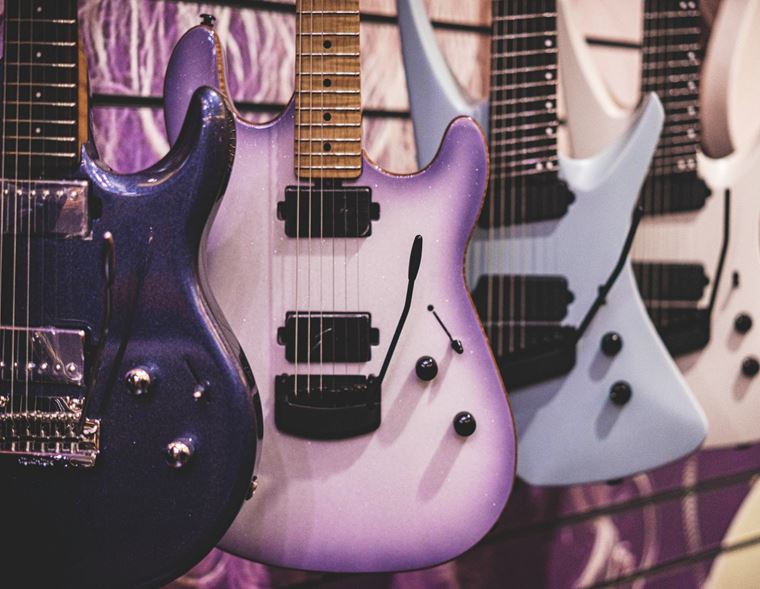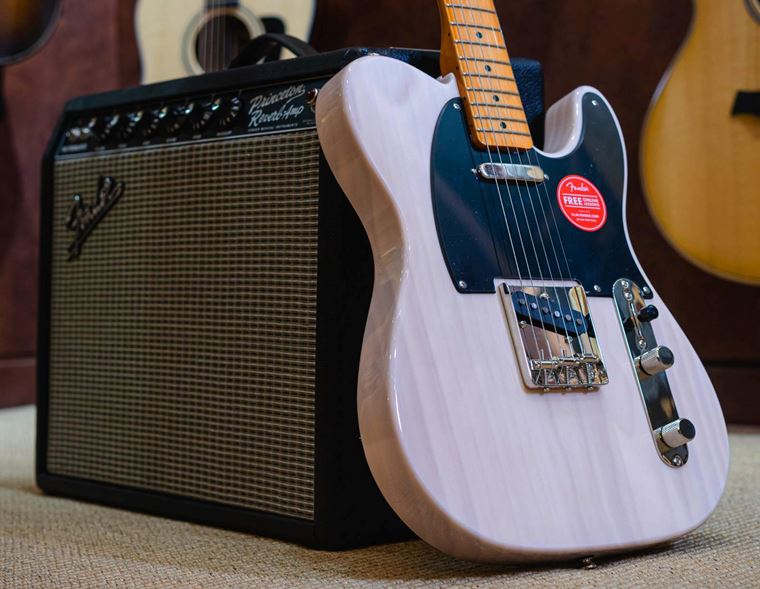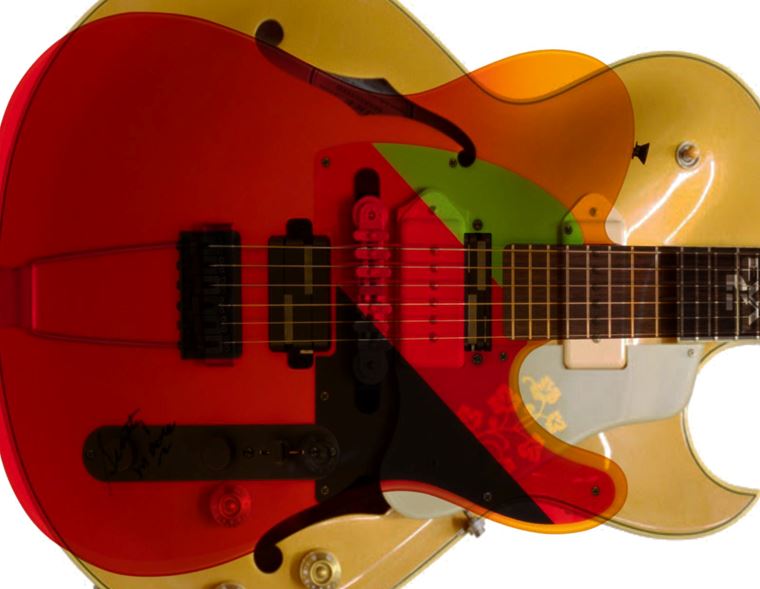(Brief) History of PRS Guitars
Published on 12 June 2023
The pinnacle of high-end guitars: bright and striking finishes on luscious flame maple tops, quality second to none and tone so versatile it covers anything from city pop to heavy metal: PRS guitars.
For a 38-year old company, PRS boasts a successful career the other two well-known guitar industry giants could easily envy. Yet fame doesn’t happen overnight and is often a result of passion and perseverance. And such was the case with the story of PRS guitars.
-History-of-PRS-Guitars_IMAGE1.jpg)
Mathematician With Rock’n’Roll Dreams
Paul Reed Smith was surrounded by music from a very young age. His mother played guitar and sang and his father was a big band leader who later gave it up to become a maths teacher. Paul was an anxious teenager and like many he found an escape in rock’n’roll. He played in various school bands and hung out with local musicians. Having come from a rather humble household, when Paul couldn’t afford something he would make it himself. He’d always enjoyed working with his hands so it came as no surprise that he started working as a repairman at a local music shop.
-History-of-PRS-Guitars_IMAGE2.jpg)
After he graduated high school, Paul wanted to go into his father’s footsteps so he signed up to study at St. Mary's College in Maryland, majoring in Maths. Smith didn’t enjoy this choice as much so one of his tutors asked him to build a guitar as a side project to help with gaining extra credit. He got an "A" and that was enough to spark a passion that would last a lifetime. The word about his skills spread and Smith got a call to repair Joe Perry from Aerosmith’s broken headstock. This was when Paul decided to quit his educational path and focus on turning his hobby into a living.
The Bird Inlays
After dropping out of college, Paul opened his own repair shop in Annapolis and with help from a handful of employees, he built one guitar per month. Being a perfectionist, what Paul built he would then test by playing his own local gigs. Hanging out at local venues was also Smith’s way of advertising his own work. He would spend hours talking to roadies, getting himself backstage passes and then showing off his hand-made guitars to any touring musicians who happened to be passing through town.
-History-of-PRS-Guitars_IMAGE3.jpg)
Early customers of Smith’s included Ted Nugent, Heart’s Howard Leese and Peter Frampton. In fact, it was Frampton who commissioned a custom guitar from Paul in 1976 and wanted it to have unique features. Paul had already been using a silhouette of a landing eagle on his guitars’ headstocks so he went with an idea to turn the usual dot fret markers into birds. Paul’s mother loved birdwatching and Paul had a special place in his heart for the feathered creatures.
-History-of-PRS-Guitars_IMAGE5.jpg)
For the inlays, he’d cut out a few little birds from a bird-watching guide and some he and his team drew by hand. The design caught on and when in 1985 Paul Reed Smith guitars officially formed, the company offered moon inlays (a dot with a crescent moon within it) and bird inlays thinking not many people would be interested in having birds on their guitar. The opposite turned to be the truth and the rest is history.
-History-of-PRS-Guitars_IMAGE4.jpg)
From the nut to the body joint the birds are as follows:
Peregrine falcon
Marsh Hawk
Ruby Throated Hummingbird
Common Tern
Cooper's Hawk
Kite
Sparrow Landing
Storm Petrel
Hawk Landing
Screech Owl On A Branch (24-fret models only)
-History-of-PRS-Guitars_IMAGE6.jpg)
Carlos Santana Endorses PRS
As a young guitar business entrepreneur, Paul’s ultimate dream was to build a guitar for Carlos Santana. The two had met before and Carlos tried some of Paul’s designs but it wasn’t until 1980 that the magic handshake happened. Being a high-profile artist, Santana made Smith work hard and it took the luthier four attempts before the virtuoso finally agreed to officially endorse the brand.
The Sorcerer's Apprentice
The timeless shape of a PRS guitar as we know it today had gone through a few changes before it became the brand’s staple. Paul knew that half of his target market wanted a Les Paul, whilst the other half preferred a Fender Strat.
-History-of-PRS-Guitars_IMAGE7.jpg)
On top of that, metal was the genre of the decade and spiky, high output axes were quickly becoming the choice for the young generation. It became a matter of survival for Paul to bring something fresh to the market. Paul was on a mission to build a guitar that was the best of both worlds and so in 1982 the Sorcerer’s Apprentice was born. This 27-fret double cutaway with bird inlays would become the route to modern Custom 24.
-History-of-PRS-Guitars_IMAGE8.jpg)
What is the PRS Custom 24?
It is the quintessential PRS model. It has been the top seller since it was brought to NAMM in 1985 (see below). PRS Custom 24 is a double cutaway solid body electric guitar, with mahogany base, flame maple top. It is equipped with a set of 85/15 humbuckers, volume & tone control and a 5-way blade switch. Its construction is a set-neck, 25” scale length and rosewood fingerboard with bird inlays and PRS’s patented tremolo. A true classic in its own right.
PRS debut at 1985 NAMM
Paul Reed Smith guitars started to get more traction when Paul toured the East Coast of the States trying to make sale deals and commission orders with local music shops. This gave his company the grounds to raise the funds to try their luck at the NAMM show. Although Paul was nervous he wouldn’t cope financially, his wife Barbara supported his dreams and convinced him NAMM was the way to go. The exhibition was a success, with Custom 24 being their secret weapon, and a turning point for PRS guitars. From that moment on, the company grew and Paul with his team of skilled luthiers kept re-inventing their range and upgrading models to suit the current trends in music business.
-History-of-PRS-Guitars_IMAGE9.jpg)
Great Minds Think Alike
Ted McCarty was a pioneer of the electric guitar design throughout the golden era of guitar building (1950s & 1960s). He served as vice president of the Gibson Corporation in 1949 and was involved in creating some of the most innovative patents the guitar industry has ever seen: the humbucking pickup, Flying V, Explorer and many more!
-History-of-PRS-Guitars_IMAGE10.jpg)
Paul Reed Smith was fascinated by the man and one day he decided to interview McCarty. The two formed a wonderful friendship and Ted became a mentor to Paul. This resulted in 1994’s introduction of the McCarty model into the PRS family. Paul built this guitar as a tribute to his idol and a way to immortalise Ted McCarty’s role in the guitar industry.
-History-of-PRS-Guitars_IMAGE11.jpg)
The 90s Breakthrough
The 90s brought a lot of changes to PRS guitars. PRS hired its 100th employee (there are 400 nowadays for comparison).
In 1996 PRS expanded its workforce and moved to a new factory in Stevensville, Maryland. That same year the PRS team also launched the company’s official website and introduced its Private Stock program offer. The Private Stock guitars feature only the finest woods and highest quality electronics making these the most impeccable and unique custom-built PRS guitars on the market; they are true pieces of art!
-History-of-PRS-Guitars_IMAGE12.jpg)
Why did Gibson sue PRS?
PRS launched their first singlecut model at NAMM in the late 2000. The body shape’s familiarity with the famous Les Paul caused Gibson to spark a lawsuit against PRS claiming it a trademark infringement. As a result, a lower state court ordered PRS to stop its singlecut guitars production. PRS appealed it and argued that there are about 30 differences between the two models. After a five-year-long battle between the two brands, in September 2005, the Sixth Circuit Court of Appeals reversed the decision ordering the dismissal of Gibson’s lawsuit against PRS calling it an unfair disqualification of competition laws. PRS immediately and successfully resumed its Singlecut guitars production.
-History-of-PRS-Guitars_IMAGE13.jpg)
Student Edition - PRS SE
Paul Reed Smith has always aimed to deliver a boutique experience combined with the best playability. Along with the popularity of the brand so grew its quality and demand, making a staple USA model a rather hefty investment. Therefore in order to cater to younger players, PRS introduced its budget-friendly line called PRS SE (Student Edition) in 2001. These guitars are mass-produced in factories outside the USA yet retain many features their high-end equivalents portray and became an instant hit worldwide.
-History-of-PRS-Guitars_IMAGE14.jpg)
2000 - The Golden Era of PRS Guitars
Aside from the lawsuit, the noughties were a brilliant era for PRS. The company not only overcame the legal battle against Gibson but also gained a star-studded line up of endorsees on their artist roster. This also included the artists' signature models released onto the market through the brand’s Core and SE line: Mark Tremonti, Dave Navarro, Orianthi, Mark Holcomb, David Grissom, Bernie Marsden, Opeth’s Mikael Akerfeldt and the aforementioned Carlos Santana.
-History-of-PRS-Guitars_IMAGE15.jpg)
Year 2009 also saw PRS branching out onto the world of acoustic guitars with their Angelus cutaway and Tonare instruments. The acoustics offered by PRS include three body shapes and several tonal options within their SE range as well as endless colour possibilities and exotic tonewoods of highest grade through their Private Stock catalogue.
-History-of-PRS-Guitars_IMAGE16.jpg)
If that wasn’t enough, PRS also hit the market with their brand new all-tube amplifiers and four years later, in 2013, a stripped-back take on the full-fat USA models, S2 line, was added to bridge the gap between the price points of their American made guitars. S2 models retain the classic CU24 body shape and construction but with an assymetrical beveled top and a 3-way blade switch instead of 5.
-History-of-PRS-Guitars_IMAGE17.jpg)
In 2018, PRS made an announcement that shook the guitar industry: a collaboration with Grammy-winning virtuoso John Mayer, who had just left Fender.
PRS brought out a series of his signature Silver Sky S-shaped guitars with bolt-on necks which were an instant success. This resulted in an additional SE line dedicated to the artist.
Pulse Artist Program
With exceptional quality and an artist roster as impressive as PRS’s, guitarists work their fingers to the bone trying to blaze their way to an endorsement with the brand. What may seem like a door only the A-lister can enter, in reality is very approachable! The team at PRS have always tried to cater for young and talented artists, no matter their background. And nothing better to prove it than launching their own endorsement program: PRS Pulse Artist.
The Pulse Artist started in 2020 and it is a simple route for local guitarists to sign up for and bag themselves support straight from PRS. Aided by local dealers, it’s aimed at skilled PRS-playing guitarists making waves in their hometown.
-History-of-PRS-Guitars_IMAGE0.jpg)
Believe in Your Dreams
This is perhaps as brief a timeline as we could present you to tell the story of one of the most influential guitar makers in the world. We hope this read gives you a sufficient insight into PRS guitars and ignites your passion for the brand. When Paul was asked what’s the moral of the story of his career, he simply answered: “Believe in your dreams”.
-History-of-PRS-Guitars_IMAGE18.jpg)












